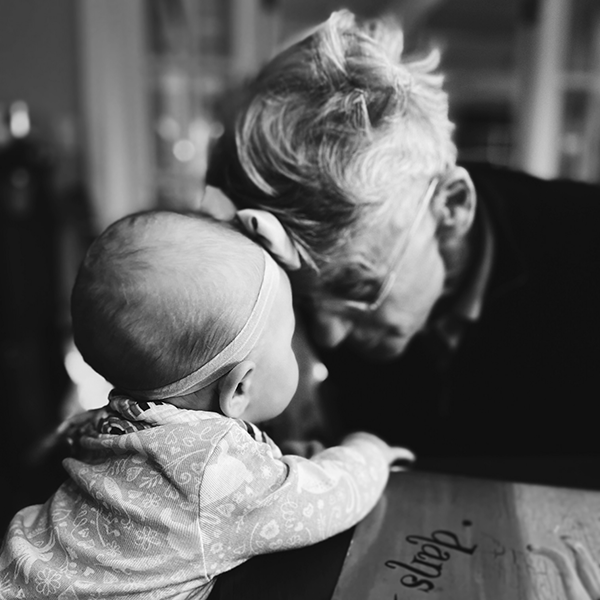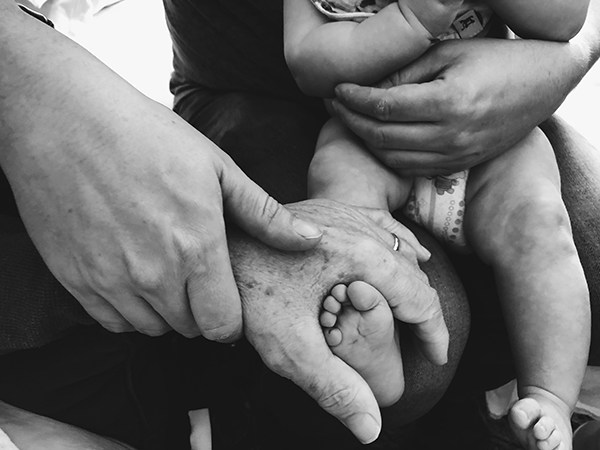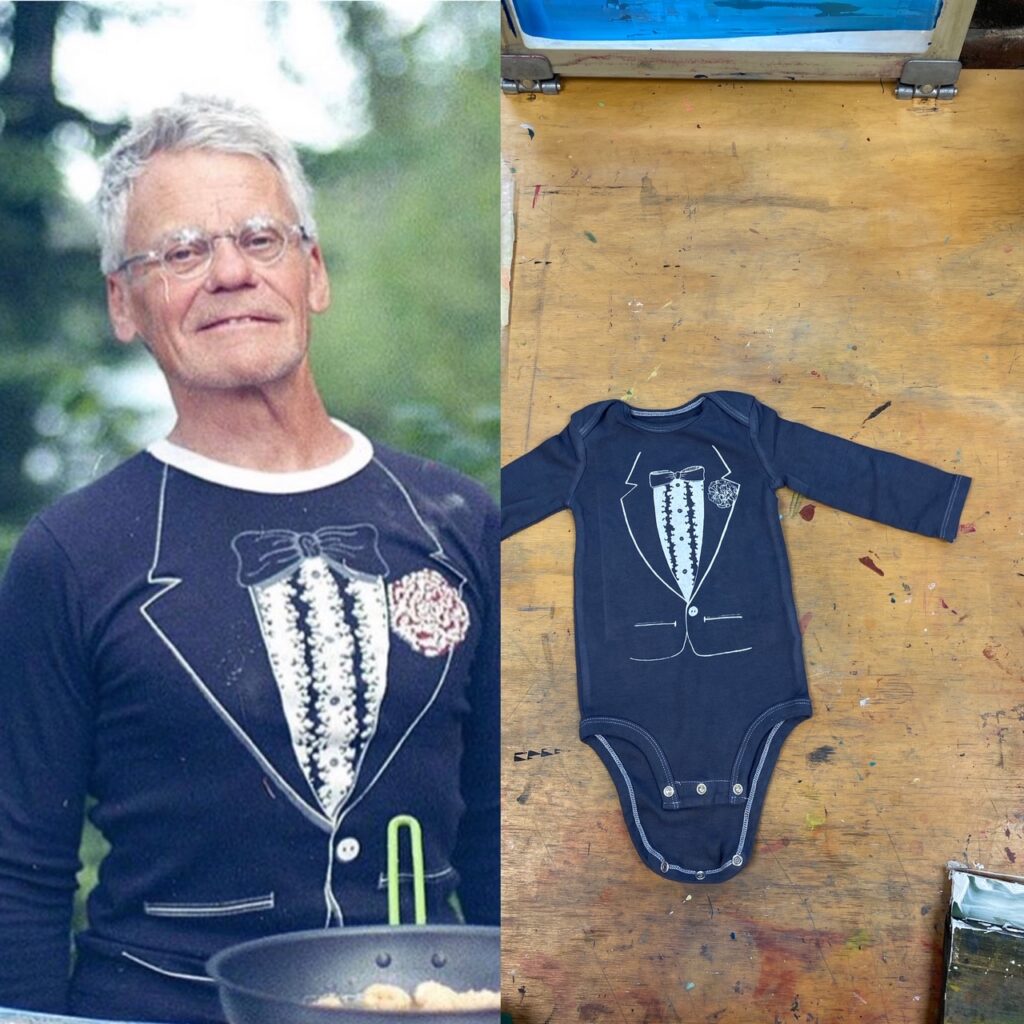Home > FULL CIRCLE: ON THE OTHER SIDE OF THE ARRANGEMENT TABLE
FULL CIRCLE: ON THE OTHER SIDE OF THE ARRANGEMENT TABLE
by Amanda Marie Eilis King
Sometimes it’s perfectly humbling to be back on the other side of our line of duty in death care—to be one of the families we would serve.
To those I have yet to meet, I’m an embalmer, funeral director, and death doula (trained with INELDA in 2017) who doubles as an illustrator and printmaker. As you can imagine, the early days of COVID were hard-hitting as an embalmer and funeral director based in Connecticut, with weeks averaging 100-plus hours during the thick of it from about March through the beginning of June 2020.
In the throes of the pandemic, my partner’s father, Tom, entered into hospice at his home in Minnesota—yes, Minneapolis of all places, our country’s epicenter of social unrest that also exploded in rightful anguish at that time. The velocity of that moment caused my partner, myself, and our infant daughter to strap ourselves in as we were pulled in a thousand different directions. In fact, it pulled Ben and Lydia, our daughter, away to Minnesota to be with Tom, while I remained in Connecticut to work for three painfully lonely and exhausting months. During Tom’s final months alive, an immeasurable light grew within him, renewing strength to the family as Lydia grew and blossomed in their presence. I happily experienced that pain of missing my 4-month-old grow into a 7-month-old because I knew that pain of missing her would be temporary and fleeting. More importantly, I knew the eventual outcome of Ben’s father dying.

Sometimes it’s perfectly humbling to be back on the other side of our line of duty in death care—to be one of the families we would serve.
To those I have yet to meet, I’m an embalmer, funeral director, and death doula (trained with INELDA in 2017) who doubles as an illustrator and printmaker. As you can imagine, the early days of COVID were hard-hitting as an embalmer and funeral director based in Connecticut, with weeks averaging 100-plus hours during the thick of it from about March through the beginning of June 2020.
In the throes of the pandemic, my partner’s father, Tom, entered into hospice at his home in Minnesota—yes, Minneapolis of all places, our country’s epicenter of social unrest that also exploded in rightful anguish at that time. The velocity of that moment caused my partner, myself, and our infant daughter to strap ourselves in as we were pulled in a thousand different directions. In fact, it pulled Ben and Lydia, our daughter, away to Minnesota to be with Tom, while I remained in Connecticut to work for three painfully lonely and exhausting months. During Tom’s final months alive, an immeasurable light grew within him, renewing strength to the family as Lydia grew and blossomed in their presence. I happily experienced that pain of missing my 4-month-old grow into a 7-month-old because I knew that pain of missing her would be temporary and fleeting. More importantly, I knew the eventual outcome of Ben’s father dying.

The Vigil
Sometimes we have to create opportunities to experience meaningful moments in life, just as we create tangible artwork meant to express meaning. On a Friday in early June, at the request of Ben when his father’s health was starting to significantly dive, I stayed at work until 4 a.m. to finish getting decedents ready for their loved ones to view before I headed out to Minnesota to be with my extended family.
At the time, I managed a “care center” for a funeral home—a term used in the funeral world for specific centers that handle everything pertaining to a decedent’s physical body. We would transfer them into our care, bathe them, embalm them if that was in their plan, repose the body for their families to come in and see them one last time—or perhaps to assist us with dressing them or doing their hair and makeup, and of course dress and casket them, cosmetize them, and set up their services at whichever funeral home they were to go to. So late into the night and early morning, I got several decedents dressed, casketed, cosmetized, and their hair done so that my team would have less of a burden with me unexpectedly going away that weekend. I then made my way to the airport to reach my partner’s family home for the final few days of his father’s life—the inevitable process of his active dying.

There was an undeniable bond between Tom and Lydia—one I loved capturing, and one in fact that helped me begin to heal from the sadness that my own father, who was deceased, would never get to meet my daughter. As the dying process took its course, and without hospice nurses present due to COVID precautions that were in place at that time in Minneapolis, I tried to help the family anticipate the “next moves” of a dying patriarch—sounds, motions, behaviors—all new and unexpected to them from someone they previously could never imagine growing so weak and mentally absent. Their father was becoming a fleeting memory right in front of their eyes, with no means to be able to stop it. But with acceptance of this, they spent final time surrounding him with soothing music and verbal stories of their adventures as a family with photo albums spread out all around him curled up in bed. In constant rotation, we helped to hold him up, adjust him, give him water and ice chips, change him, clean him, massage him, and surround him with pure, unwavering love.

There was an undeniable bond between Tom and Lydia—one I loved capturing, and one in fact that helped me begin to heal from the sadness that my own father, who was deceased, would never get to meet my daughter. As the dying process took its course, and without hospice nurses present due to COVID precautions that were in place at that time in Minneapolis, I tried to help the family anticipate the “next moves” of a dying patriarch—sounds, motions, behaviors—all new and unexpected to them from someone they previously could never imagine growing so weak and mentally absent. Their father was becoming a fleeting memory right in front of their eyes, with no means to be able to stop it. But with acceptance of this, they spent final time surrounding him with soothing music and verbal stories of their adventures as a family with photo albums spread out all around him curled up in bed. In constant rotation, we helped to hold him up, adjust him, give him water and ice chips, change him, clean him, massage him, and surround him with pure, unwavering love.
We held Lydia close to him, so she could continue to interact with him—and every time she touched him or cooed near him, an undeniable smirk came across his absent-minded face. Ben would sit near Tom and hold his father’s hand onto our daughter’s feet and hands so that he would know she was still there as the days turned into nights. I’m fairly sure Ben also savored what he knew would be the final moments of physically having the capability to hold onto his father. When my own father died, I foolishly thought it crude to photograph the final days, but with lessons learned I caught a few moments to now forever exist in time as Tom was dying: Images were captured of Tom’s interactions with his children, and one of his grandchildren—our daughter, Lydia. It had been a long, exhausting, sleep-deprived experience, yet filled with so many small, quiet moments that speak to the vigil they held for one of the most cherished members of the family.
Tom’s Death
Tom died early in the morning hours as everyone finally took rest after three days of holding vigil. A common time for people who are doted on with around-the-clock care by loved ones to let go—when no one is watching and there’s no one to let down. Word spread in whispers as family scattered throughout the house began to wake up, and a pot of coffee instinctually began to percolate even though it was only truly a little after 2 a.m. Rigor set in quickly, and though his sons were hesitant to touch him, I did my “funeral director thing” and openly touched his hand, arm, and brushed my fingers through his hair in front of them—a silent notion to let them know it was “OK”; that this is still their father’s body and one they have known their entire lives. This is a common unconscious signal I like to do in front of families when they come in to see their loved one for the first time and seem upset to be hesitant to approach them. Many people do not know what is “allowed” or “OK” to do when placed in that situation because it typically is a foreign experience, so they freeze. As I look at them and talk to them about their loved one, I slowly make my way to the body and either subtly lay my hand on the decedent’s hand or on their arm or brush my fingers through their hair. You’d be amazed how quickly their loved ones then move in to do the same. It’s honestly quite a beautiful and magical experience to have the honor to be a part of this moment with them.
Tom’s sons took my bait and affectionately approached their father’s body as they bathed him a final time and dressed him for his cremation. Originally, I was to embalm him, but the unexpected days of taking care of him actively dying was a peaceful amount of “enough” for his family, so I agreed with them against it (especially during COVID-era services, when no one but the direct family would have been able to have seen him anyways, per Minnesota law at the time). And believe me, if you know me as a funeral director, I am the first person to preach for a final viewing, but having been immersed in this experience with them I knew this was the right thing to do. My agreement caught them with relief—they had gotten what they needed, and I undeniably saw it in all of their eyes. I had already been in talks with the funeral home that we were to use in Minnesota and gave them the “imminent” heads up that we all appreciate the day before. But when the two gentlemen arrived to transfer Tom, that dreaded gut-wrenching feeling of not being ready still hit—even though they waited to come until the time we requested. Time is the one gift we cannot get back as it constantly slips away from us. We’re never ready. They’re never ready.
What to Wear
There’s no market for infant funeral wear, so my brain fretted over what to get our 7-month-old to wear to his church memorial service the following weekend. Now, Tom was not only an intellectual, but also a master of wit—one of his favorite shirts was a tuxedo T-shirt, forever classy but also forever playful. I strongly believe in the littlest of things having great impacts on our human experiences, so I decided to hand-draw and screen-print a copy of his infamous T-shirt onto a onesie for Lydia to wear to his services—a playful homage to her grandfather. But I’ll be honest: It was therapeutic for me to create in the print shop as well. With the adoption of safer COVID measures, and my long hours thankfully dwindling, I was fortunate enough to get back in my printmaking studio every other Thursday as a hideaway to breathe and create; isolated from being surrounded by anguish, hopelessness, and of course the many facets of death on the daily. It was so nice, and more importantly, needed.

What to Wear
There’s no market for infant funeral wear, so my brain fretted over what to get our 7-month-old to wear to his church memorial service the following weekend. Now, Tom was not only an intellectual, but also a master of wit—one of his favorite shirts was a tuxedo T-shirt, forever classy but also forever playful. I strongly believe in the littlest of things having great impacts on our human experiences, so I decided to hand-draw and screen-print a copy of his infamous T-shirt onto a onesie for Lydia to wear to his services—a playful homage to her grandfather. But I’ll be honest: It was therapeutic for me to create in the print shop as well. With the adoption of safer COVID measures, and my long hours thankfully dwindling, I was fortunate enough to get back in my printmaking studio every other Thursday as a hideaway to breathe and create; isolated from being surrounded by anguish, hopelessness, and of course the many facets of death on the daily. It was so nice, and more importantly, needed.

And as coincidences always seem to happen when most unexpected, but perhaps when they’re meant to occur, Ben’s family decided to use a photo of Tom in his tuxedo shirt for his memorial service without knowing what I had made for them. His family was overwhelmed with love at the sight of Lydia in her onesie that can now be passed to all future grandchildren to wear in his honor.
I share this experience to shed light on how training as an end-of-life doula has aided in developing my compassion as a funeral director. It has allowed me to imagine and recognize the events that may unfold before we usually step into the picture for families. So, when we as funeral directors finally enter the scene for many of our families, they could be coming out of a similar experience—one that undoubtedly morphs their grief. This is something I remind directors to hold in thought when serving families, and a perfect reminder that what we do and how we can serve can truly go full circle.


And as coincidences always seem to happen when most unexpected, but perhaps when they’re meant to occur, Ben’s family decided to use a photo of Tom in his tuxedo shirt for his memorial service without knowing what I had made for them. His family was overwhelmed with love at the sight of Lydia in her onesie that can now be passed to all future grandchildren to wear in his honor.
I share this experience to shed light on how training as an end-of-life doula has aided in developing my compassion as a funeral director. It has allowed me to imagine and recognize the events that may unfold before we usually step into the picture for families. So, when we as funeral directors finally enter the scene for many of our families, they could be coming out of a similar experience—one that undoubtedly morphs their grief. This is something I remind directors to hold in thought when serving families, and a perfect reminder that what we do and how we can serve can truly go full circle.
Bio:
Amanda Marie Eilis King, CFSP, is a licensed embalmer and funeral director currently in Connecticut with CT Life Tributes. She presents seminars to various state, national, and international organizations on the topics of embalming, restorative techniques, color theory, and pediatric funeral care. Amanda also often undertakes illustration and photography work for publications within the mortuary field. She can be reached at AMEK Mortuary Seminars.
